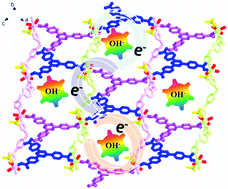Two-fold interpenetrated Mn-based metal–organic frameworks (MOFs) as battery-type electrode materials for charge storage†
Abstract
Two novel interpenetrated 2-fold Mn-based metal–organic frameworks (MOFs) (SC-7 and SC-8), assembled from the rigid ligand H3TATB (4,4′,4′′-s-triazine-2,4,6-triyl-tribenzoic acid) and Mn ions with the assistance of the flexible N-donor linker BIB (bis((1H-imidazol-1-yl)methyl)benzene) or TIPA (tris(4-imidazolylphenyl)amine), have been successfully prepared. The as-obtained MOFs show two distinct topological structures with the symbols 44·62 and (52·6)(53·6·73·82·9) due to discrepancies between the flexibilities of the bi-imidazole and tri-imidazole linkers. The electrodes based on the as-prepared bulk Mn-MOFs behave as alkaline batteries in electrochemical cells and deliver high capacities (279 and 172 mA h g−1 at 1 A g−1 for SC-7 and SC-8, respectively). Theoretical mechanism analyses indicate that the surface-controlled (k1v) process can be transformed into a diffusion-dominated (k2v1/2) process when the charging time exceeds 30 seconds in the MOF-based systems. Our research provides a new strategy to construct an increasing number of stable redox sites in MOFs for application to battery-capacitor hybrid devices.



 Please wait while we load your content...
Please wait while we load your content...